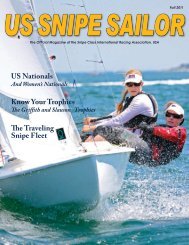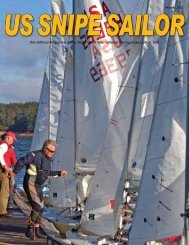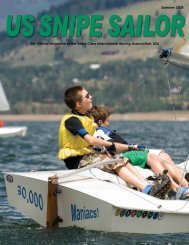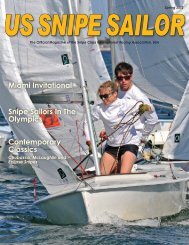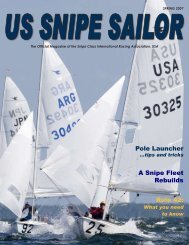2010 Classic Snipe Rally Know Your Trophies Strategies for the ...
2010 Classic Snipe Rally Know Your Trophies Strategies for the ...
2010 Classic Snipe Rally Know Your Trophies Strategies for the ...
You also want an ePaper? Increase the reach of your titles
YUMPU automatically turns print PDFs into web optimized ePapers that Google loves.
intelligently while staying in check with your competition.<br />
• Gaining from behind: The lighter <strong>the</strong> wind, <strong>the</strong> more<br />
important clear air becomes. Since that’s not always easy to<br />
get when fighting your way through <strong>the</strong> pack, staying in phase<br />
while minimizing <strong>the</strong> damage of dirty air becomes a more<br />
sensible approach. We’ve all seen <strong>the</strong> “Hail-Mary” pay off at<br />
some time or ano<strong>the</strong>r, when one boat heads far off to a corner,<br />
tacks once, and miraculously passes <strong>the</strong> fleet. Hoping <strong>for</strong> a<br />
miracle isn’t much of a strategy though, so keep your options<br />
open by avoiding <strong>the</strong> laylines until <strong>the</strong> end of <strong>the</strong> beat. This<br />
doesn’t mean that tacking up <strong>the</strong> middle is necessarily <strong>the</strong> way<br />
to go; in light air, particularly in a big fleet, <strong>the</strong> middle of <strong>the</strong><br />
course tends to have less pressure and more unstable shifts<br />
due to <strong>the</strong> presence of all <strong>the</strong> o<strong>the</strong>r boats. Determine which<br />
side you like, work <strong>the</strong> shifts as <strong>the</strong>y come, and keep your air<br />
as clear as possible.<br />
Approaching <strong>the</strong> Finish Line<br />
As you get into <strong>the</strong> last 1/3 of <strong>the</strong> final leg, look around <strong>for</strong><br />
clues as to <strong>the</strong> shifts to be expected near <strong>the</strong> line, especially<br />
if <strong>the</strong>y happen to be near or just to windward of <strong>the</strong> finish<br />
line. Flagpoles, smokestacks, and o<strong>the</strong>r sailboats may all<br />
demonstrate signs of a coming shift up <strong>the</strong> course.<br />
Finish lines, like start lines, often have one end that is more<br />
favored than <strong>the</strong> o<strong>the</strong>r. Unlike <strong>the</strong> start line, <strong>the</strong> end that<br />
is fur<strong>the</strong>r downwind is <strong>the</strong> favored end. It’s always best to<br />
finish at <strong>the</strong> favored end, since anywhere else along <strong>the</strong> line<br />
The Women’s International Match Racing Association<br />
(WIMRA) was <strong>for</strong>med in 1996 <strong>for</strong> <strong>the</strong> purpose of promoting,<br />
coordinating and supervising<br />
women’s international match-race<br />
sailing, and to campaign <strong>for</strong> <strong>the</strong><br />
inclusion of women’s match racing<br />
in <strong>the</strong> Olympics.<br />
US SNIPE SAILOR Fall <strong>2010</strong><br />
would be wasted distance sailed. Look at <strong>the</strong> flags on <strong>the</strong><br />
committee boat <strong>for</strong> a first clue; <strong>the</strong> leeward (free flying) edge<br />
of a flag will point towards <strong>the</strong> favored end. If <strong>the</strong> flags don’t<br />
tell you much, plan your final approach to <strong>the</strong> finish from <strong>the</strong><br />
“crossroads”—<strong>the</strong> intersection point between <strong>the</strong> laylines<br />
<strong>for</strong> ei<strong>the</strong>r end of <strong>the</strong> finish line. If you get to this point and<br />
one end is clearly closer than <strong>the</strong> o<strong>the</strong>r, head <strong>for</strong> that end. If<br />
it looks about even, it’s a judgment call. If it’s going to be a<br />
crowded finish, it’s tactically beneficial to be on starboard tack<br />
with <strong>the</strong> right-of-way.<br />
Keep up plenty of speed as you approach <strong>the</strong> line,<br />
particularly in any chop. If you find that <strong>the</strong> finish is going<br />
to be close with ano<strong>the</strong>r boat and you need to shoot head-towind,<br />
momentum will be key. Give a little bit of leeward heel<br />
while keeping <strong>the</strong> main in tight and easing <strong>the</strong> jib to make<br />
your luff as smooth as possible; if you dig <strong>the</strong> wea<strong>the</strong>r chine<br />
or have <strong>the</strong> jib in too tight while trying to head up, you’ll just<br />
stall <strong>the</strong> foils. You shouldn’t shoot <strong>the</strong> line until <strong>the</strong> last halfboatlength<br />
or so; <strong>Snipe</strong>s are relatively light, so <strong>the</strong>y can lose<br />
<strong>the</strong>ir momentum quickly.<br />
Whe<strong>the</strong>r you cross <strong>the</strong> line near <strong>the</strong> top or <strong>the</strong> bottom of<br />
<strong>the</strong> fleet, <strong>the</strong> moments following <strong>the</strong> finish provide a good<br />
opportunity to look back on <strong>the</strong> race, review what went well<br />
and what could be improved, and <strong>the</strong>n look <strong>for</strong>ward again.<br />
After all, <strong>the</strong> finish of one race is just <strong>the</strong> first step towards <strong>the</strong><br />
start of <strong>the</strong> next one.<br />
Show your support. Become an official member of <strong>the</strong><br />
organization that was successful in helping to get<br />
Women’s Match Racing into <strong>the</strong> 2012<br />
Olympic Games and enjoy all <strong>the</strong><br />
benefits and privileges exclusive to<br />
our members. Join at wimra.org.



